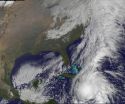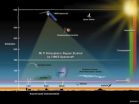(Press-News.org) Chapel Hill, NC – One of the most frustrating problems faced by doctors who treat pancreatic cancer is the lack of effective therapeutic options. More than 38,000 people in the United States die of the disease each year, and new drugs and treatments are desperately needed.
For almost three decades, scientists and physicians have known that a gene called the KRAS oncogene is mutated in virtually all pancreatic cancers, making it an important target for scientists looking for a way to stop the growth of pancreatic cancer tumors. The problem is that the KRAS gene triggers cancer cell growth in numerous ways, through multiple cell signaling pathways, and scientists have had difficulty determining which one will be the most promising to block – an important first step in designing a drug for use in patients.
In a paper published today in the Journal of Biological Chemistry, a team from UNC Lineberger Comprehensive Cancer Center has narrowed the focus of this scientific quest to a protein called RGL2.
According to Channing Der, PhD, who led the research, "The pathway we talk about this paper is one we have investigating for more than five years. We think it is an attractive target for achieving what has, to date, been impossible: making a KRAS-blocking drug."
Der, who is a distinguished professor of pharmacology and UNC Lineberger member, says, "We are particularly optimistic about RGL2 because we know that this protein is a critical component of KRAS signaling to another class of proteins called Ral GTPases, which are essential for the growth of almost all pancreatic tumors."
Working with Jen Jen Yeh, MD, assistant professor of surgery, Sharon Campbell, PhD, professor of biochemistry and biophysics, Der and his laboratory team were able to demonstrate that RGL2 is overexpressed – not only in pancreatic tumor cells grown in the laboratory but also in tissue taken from pancreatic cancer patients.
According to Der, "Many ideas work in the artificial environment of cell culture but not in real cancer patients. Our work with actual pancreatic tumor tissue makes us optimistic that our new understanding of this pathway can lead to a therapeutic impact for the cancer patient."
INFORMATION:
Other members of the UNC Lineberger team include postdoctoral fellow Dominico Vigil, PhD, Timothy Martin and Falina Williams.
The research was supported by grants from the National Institutes of Health, UNC Lineberger's National Cancer Institute Special Program of Research Excellence (SPORE) in Gastrointestinal Cancer, the Emerald Foundation, the American Cancer Society, the Kimmel Foundation, the American College of Surgeons and by the University Cancer Research Fund.
UNC team discovers promising target for new pancreatic cancer treatments
Cell signaling protein may hold key to blocking long-studied genetic mutation
2010-11-06
ELSE PRESS RELEASES FROM THIS DATE:
Overweight children have different eating patterns than normal weight children
2010-11-06
Overweight children reported more frequent intake of healthy foods such as fruit, vegetables, fish, brown bread and potatoes as well as low-energy cheese and yoghurt compared with normal weight children. This comes from a recent study from researchers at Telemark University College, Norway and the Norwegian Institute of Public Health.
The study showed that:
Overweight children drank juice and artificially sweetened soft drinks more often, while the normal weight children drank carbonated drinks and ate unhealthy foods and processed foods such as burgers, sausages, ...
Infants' hemodynamic responses to happy and angry facial expressions
2010-11-06
Japanese research group led by Prof. Ryusuke Kakigi and Dr. Emi Nakato (National Institute for Physiological Sciences: NIPS) and Prof. Masami K Yamaguchi (Chuo University) found that the hemispheric differences in the temporal area overlying superior temporal sulcus (STS) when processing positive (happy) and negative (angry) facial expressions in infants. Their finding was reported in NeuroImage.
Near infrared spectroscopy (NIRS) is an optical imaging technique that can measure changes in the concentrations of oxyhemoglobin (oxy-Hb), deoxyhemoglobin (deoxy-Hb), and total ...
Unexpectedly small effects of mutations in bacteria bring new perspectives
2010-11-06
Most mutations in the genes of the Salmonella bacterium have a surprisingly small negative impact on bacterial fitness. And this is the case regardless whether they lead to changes in the bacterial proteins or not. This is shown by Uppsala University scientists in an article being published today in the prestigious journal Science.
The researchers have examined the impact of mutations on the rate of growth of the Salmonella bacterium and show that most mutations have generally very small effects. Moreover the negative effects are of the similar magnitude for changes that ...
Should our biggest climate change fear be fear itself?
2010-11-06
From apocalyptic forecasting to estimates of mass extinctions, climate change is a topic which is filled with fearful predictions for the future. In his latest research, published in WIREs Climate Change, historian Matthias Dörries examines the cultural significance of fear and how it became a central presence in current debates over climate change.
Climatic change, as represented by the media, often prompts headlines predicting disastrous events, frequently adopting fear laden language including analogies with war and warnings of the imminence or irreversibility of ...
Looking older than your age may not be a sign of poor health: Study
2010-11-06
Toronto, Ontario, November 5, 2010 – Even though most adults want to avoid looking older than their actual age, research led by St. Michael's Hospital shows that looking older does not necessarily point to poor health. The study found that a person needed to look at least 10 years older than their actual age before assumptions about their health could be made.
"Few people are aware that when physicians describe their patients to other physicians, they often include an assessment of whether the patient looks older than his or her actual age," says Dr. Stephen Hwang, a ...
New statistical model moves human evolution back 3 million years
2010-11-06
Evolutionary divergence of humans from chimpanzees likely occurred some 8 million years ago rather than the 5 million year estimate widely accepted by scientists, a new statistical model suggests.
The revised estimate of when the human species parted ways from its closest primate relatives should enable scientists to better interpret the history of human evolution, said Robert D. Martin, curator of biological anthropology at the Field Museum, and a co-author of the new study appearing in the journal Systematic Biology. Here is a link to the article: http://sysbio.oxfordjournals.org/content/early/2010/11/04/sysbio.syq054.full.html?ijkey=CaQif1LgTAd7xOD&keytype=ref
Working ...
'Prima donna' protein doesn't work well in pairs
2010-11-06
HOUSTON -- (Nov. 5, 2010) -- A new study by Rice University bioengineers finds that the workhorse proteins that move cargo inside living cells behave like prima donnas. The protein, called kinesin, is a two-legged molecular machine. Rice's scientists invented tools that could measure the pulling power of kinesin both singly and in pairs, and they report this week in Biophysical Journal that kinesins don't work well together -- in part because they are so effective on their own.
"Researchers have been investigating the mechanical properties of individual motor proteins ...
Story tips from the Department of Energy's Oak Ridge National Laboratory, November 2010
2010-11-06
VEHICLES -- Charge on the fly . . .
A prototype charging system for electric and hybrid vehicles is helping demonstrate a technology that could one day play a key role in the electrification of America's highways. The bench-scale prototype developed at Oak Ridge National Laboratory is allowing researchers to quantify the power transfer parameters necessary to wirelessly charge stationary and moving vehicles. "Our laboratory tests have been successful in transmitting greater than 4 kilowatts," said Laura Marlino of the Energy and Transportation Science Division. "This ...
GOES-13 Satellite sees Hurricane Tomas lashing Haiti and eastern Cuba today
2010-11-06
Tomas strengthened to hurricane status and is currently lashing Hispaniola and eastern Cuba today and the GOES-13 satellite provided a visible image of its extensive cloud cover.
The Geostationary Operational Environmental Satellite known as GOES-13 captured a visible image of Hurricane Tomas on Nov. 5 at 1331 UTC (9:31 a.m. EDT) centered over the southwestern tip of Haiti. In the image the clouds to the north of Tomas are associated with a cold front off the eastern U.S. coast. GOES satellites are operated by NOAA. The NASA GOES Project at NASA's Goddard Space Flight ...
NASA extends TIMED mission for fourth time
2010-11-06
Nine years after beginning its unprecedented look at the gateway between Earth's environment and space, not to mention collecting more data on the upper atmosphere than any other satellite, NASA's Thermosphere Ionosphere Mesosphere Energetics and Dynamics (TIMED) mission has been extended again.
Before the launch of TIMED, the mesosphere and lower thermosphere/ionosphere -- which help protect us from harmful solar radiation -- had been one of the least explored and understood regions of our environment.
"The middle part of the atmosphere was the part we kind of ignored," ...
LAST 30 PRESS RELEASES:
Making lighter work of calculating fluid and heat flow
Normalizing blood sugar can halve heart attack risk
Lowering blood sugar cuts heart attack risk in people with prediabetes
Study links genetic variants to risk of blinding eye disease in premature infants
Non-opioid ‘pain sponge’ therapy halts cartilage degeneration and relieves chronic pain
AI can pick up cultural values by mimicking how kids learn
China’s ecological redlines offer fast track to 30 x 30 global conservation goal
Invisible indoor threats: emerging household contaminants and their growing risks to human health
Adding antibody treatment to chemo boosts outcomes for children with rare cancer
Germline pathogenic variants among women without a history of breast cancer
Tanning beds triple melanoma risk, potentially causing broad DNA damage
Unique bond identified as key to viral infection speed
Indoor tanning makes youthful skin much older on a genetic level
Mouse model sheds new light on the causes and potential solutions to human GI problems linked to muscular dystrophy
The Journal of Nuclear Medicine ahead-of-print tip sheet: December 12, 2025
Smarter tools for peering into the microscopic world
Applications open for funding to conduct research in the Kinsey Institute archives
Global measure underestimates the severity of food insecurity
Child survivors of critical illness are missing out on timely follow up care
Risk-based vs annual breast cancer screening / the WISDOM randomized clinical trial
University of Toronto launches Electric Vehicle Innovation Ontario to accelerate advanced EV technologies and build Canada’s innovation advantage
Early relapse predicts poor outcomes in aggressive blood cancer
American College of Lifestyle Medicine applauds two CMS models aligned with lifestyle medicine practice and reimbursement
Clinical trial finds cannabis use not a barrier to quitting nicotine vaping
Supplemental nutrition assistance program policies and food insecurity
Switching immune cells to “night mode” could limit damage after a heart attack, study suggests
URI-based Global RIghts Project report spotlights continued troubling trends in worldwide inhumane treatment
Neutrophils are less aggressive at night, explaining why nighttime heart attacks cause less damage than daytime events
Menopausal hormone therapy may not pose breast cancer risk for women with BRCA mutations
Mobile health tool may improve quality of life for adolescent and young adult breast cancer survivors
[Press-News.org] UNC team discovers promising target for new pancreatic cancer treatmentsCell signaling protein may hold key to blocking long-studied genetic mutation


